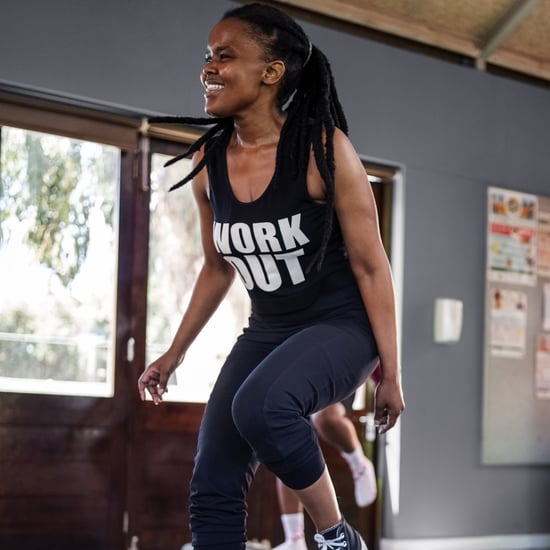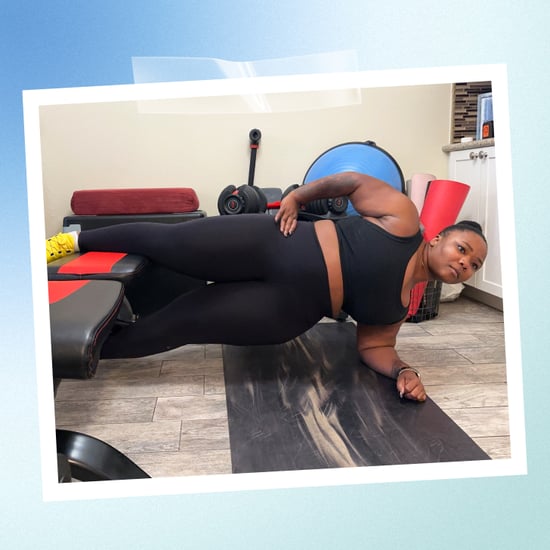How Ankle Strengthening Exercises Help Avoid Gym Injuries
Why Strengthening Your Ankles Actually Matters

Never have I ever walked into the gym thinking, "I'm going to work on my ankles today!" It's probably my most ignored body part when it comes to strength training, but that's definitely not for my own good, especially as a runner and a lover of all things HIIT.
"Your ankles are comprised of a variety of muscles and ligaments that are used to absorb forces and propel your body when walking, running, changing direction, jumping, and hopping," Jason Machowsky, RD, CSSD, RCEP, CSCS, exercise physiologist at Hospital for Special Surgery, said.
"Having weak ankles can compromise performance and increase risk of injury of these activities."
But what causes someone to have weak ankles, exactly?
Sometimes it's a previous injury to the ankle, like an ankle sprain. Certain sports are linked with an increased risk of ankle injuries, too. Machowsky pointed to one study profiling ankle injuries in high school athletes thaat found that sports involving jumping in close proximity to other players and swift changes of direction while running had higher rates of ankle injuries.
Machowsky also noted that sports that involve high landing or change of direction loads — like gymnastics and certain styles of dance — may have a risk of ankle injuries.
Other times, weak ankles result from simply not performing exercises that promote adequate range of motion.
Building strength in your ankles not only decreases this risk of injury, but also allows "you to move more efficiently through your legs and create or absorb more force through the ground, which can certainly create more strength and power in the sport specific movements described earlier," Machowsky explained.
You can start to build strength in your ankles by adding in a few exercises to your warmup and within your leg workout routine.
Machowsky recommended these ankle-strengthening moves ahead.
"Easier versions can be done as a part of your warmup to get the muscles active," he explained.
"More challenging versions can be done as a secondary leg exercise after your primary leg exercises so you don't prematurely fatigue the ankles for harder activities — i.e., jumping, squatting, deadlifting."
Calf Raises
- Stand in good posture near a supportive object like a table or back of a chair.
- Use the muscles of your lower legs to raise up onto your toes and then slowly lower back down.
- To progress, raise yourself up on both legs and then slowly lower down on just one leg. Alternate which leg lowers.
- To progress further, raise yourself up and down on one leg only.
- Perform eight to 15 reps of each, or as tolerated.
Single Leg RDL
- Stand on one leg with the opposite knee raised and bent to about 90 degrees. Note: if balancing on one leg is challenging, you can start with just this and hold for a specific amount time, up to 30 seconds.
- Slowly hinge at your hips, allowing your chest to fall forward as your butt and hips push back.
- Maintain alignment from foot to knee to hip, don't let the knee fall in.
- You should feel like you are working the glute/hamstring of the stance leg to control the motion down and back up.
When your ankles are tight, Machowsky recommended stretching and/or foam rolling to boost your range of motion and flexibility.
"Ankle stretching can be done standing in split stance (calf stretch) or with feet up on a wedge. You can hold the stretches with the knees straight, and then with the knee lightly bent to get the different areas of the calf," he added.
If you have any questions about how to work ankle stretching or strengthening into your gym routine, it's always best to consult the individualized help of a certified personal trainer or physical therapist.
Click here for more health and wellness stories, tips, and news.








